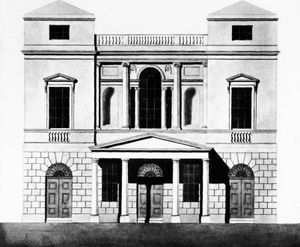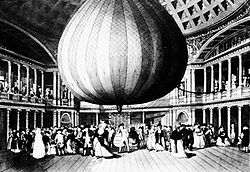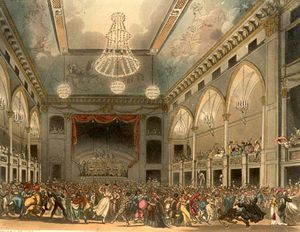
Pantheon, London
Encyclopedia

Oxford Street
Oxford Street is a major thoroughfare in the City of Westminster in the West End of London, United Kingdom. It is Europe's busiest shopping street, as well as its most dense, and currently has approximately 300 shops. The street was formerly part of the London-Oxford road which began at Newgate,...
, London
London
London is the capital city of :England and the :United Kingdom, the largest metropolitan area in the United Kingdom, and the largest urban zone in the European Union by most measures. Located on the River Thames, London has been a major settlement for two millennia, its history going back to its...
, England
England
England is a country that is part of the United Kingdom. It shares land borders with Scotland to the north and Wales to the west; the Irish Sea is to the north west, the Celtic Sea to the south west, with the North Sea to the east and the English Channel to the south separating it from continental...
. It was designed by James Wyatt
James Wyatt
James Wyatt RA , was an English architect, a rival of Robert Adam in the neoclassical style, who far outdid Adam in his work in the neo-Gothic style.-Early classical career:...
and opened in 1772. The main rotunda
Rotunda (architecture)
A rotunda is any building with a circular ground plan, sometimes covered by a dome. It can also refer to a round room within a building . The Pantheon in Rome is a famous rotunda. A Band Rotunda is a circular bandstand, usually with a dome...
was one of the largest rooms built in England up to that time and had a central dome
Dome
A dome is a structural element of architecture that resembles the hollow upper half of a sphere. Dome structures made of various materials have a long architectural lineage extending into prehistory....
somewhat reminiscent of the celebrated Pantheon
Pantheon, Rome
The Pantheon ,Rarely Pantheum. This appears in Pliny's Natural History in describing this edifice: Agrippae Pantheum decoravit Diogenes Atheniensis; in columnis templi eius Caryatides probantur inter pauca operum, sicut in fastigio posita signa, sed propter altitudinem loci minus celebrata.from ,...
in Rome
Rome
Rome is the capital of Italy and the country's largest and most populated city and comune, with over 2.7 million residents in . The city is located in the central-western portion of the Italian Peninsula, on the Tiber River within the Lazio region of Italy.Rome's history spans two and a half...
. It was built as a set of winter assembly rooms
Assembly rooms
In Great Britain and Ireland, especially in the 18th and 19th centuries, assembly rooms were gathering places for members of the higher social classes open to members of both sexes. At that time most entertaining was done at home and there were few public places of entertainment open to both sexes...
and later briefly converted into a theatre. Before being demolished in 1937, it was a bazaar and a wine merchant's show room for over a hundred years. Marks and Spencer's "Oxford Street Pantheon" branch, at 173 Oxford Street now occupies the site.
Construction

Great Marlborough Street
Great Marlborough Street runs west to east through the western part of Soho in London. At its western end it joins Regent Street. Streets intersecting, or meeting with, Great Marlborough Street are, from west to east, Kingly Street, Argyll Street, Carnaby Street, and Poland Street...
, Poland Street and Oxford Street. He had some connections with fashionable society, including a lady of means named Margaretta Maria Ellice, who was involved in the management of a fashionable set of assembly rooms in Soho Square
Soho Square
Soho Square is a square in Soho, London, England, with a park and garden area at its centre that dates back to 1681. It was originally called King Square after Charles II, whose statue stands in the square. At the centre of the garden, there is a distinctive half-timbered gardener's hut...
. Miss Ellice was briefly Turst's main financial backer, and took soundings to ensure that a new place of public entertainment on an ambitious scale for the winter season similar to Ranelagh Gardens
Ranelagh Gardens
Ranelagh Gardens were public pleasure gardens located in Chelsea, then just outside London, England in the 18th century.-History:The Ranelagh Gardens were so called because they occupied the site of Ranelagh House, built in 1688-89 by the first Earl of Ranelagh, Treasurer of Chelsea Hospital ,...
for the summer, would be "likely to meet with the Approbation of the Nobility in General". This assurance being forthcoming the scheme went ahead.
After falling out with Miss Ellice, who had initially agreed to buy thirty of the fifty shares in the business for £10,000, but soon withdrew, Turst issued fifty shares at £500 each and found buyers for all of them except one, which he kept for himself. This provided a budget of £25,000 and work began in mid 1769.

James Wyatt
James Wyatt RA , was an English architect, a rival of Robert Adam in the neoclassical style, who far outdid Adam in his work in the neo-Gothic style.-Early classical career:...
. He was to become one of the most prominent British architects of his generation, but at that time he was unknown and aged just twenty-two or twenty-three. He appears to have had some sort of indirect connection with Turst, perhaps through his older brother Samuel
Samuel Wyatt
Samuel Wyatt was an English architect and engineer. A member of the Wyatt family, which included several notable 18th and 19th century English architects, his work was primarily in a neoclassical style.-Career:...
, who was to be the main contractor for the project.
The artists and craftsmen involved included the plasterer Joseph Rose, the sculptor Joseph Nollekens
Joseph Nollekens
Joseph Nollekens was a sculptor from London generally considered to be the finest British sculptor of the late 18th century. He was also a founder member of the Royal Academy in 1768.-Life:...
, who was paid £160 for four statues of Britannia, Liberty, the King and the Queen, and John Stretzle, who built the organ for £300.
In August 1769, Turst purchased a leasehold house on the west side of Poland Street which backed on to the site of the Pantheon and built a secondary entrance there. This unbudgeted cost added more fuel to the legal fire. In 1771 one of the shareholders filed a bill of complaint against Turst in the Court of Chancery
Court of Chancery
The Court of Chancery was a court of equity in England and Wales that followed a set of loose rules to avoid the slow pace of change and possible harshness of the common law. The Chancery had jurisdiction over all matters of equity, including trusts, land law, the administration of the estates of...
, complaining of dishonest treatment. In 1773 and again in 1782 Turst in his turn filed complaints against several other shareholders. The outcome of these suits is not known.
The building


Portico
A portico is a porch leading to the entrance of a building, or extended as a colonnade, with a roof structure over a walkway, supported by columns or enclosed by walls...
, and the two side doorways opened to a vestibule, 50 feet (15.2 m) wide and 15 feet (4.6 m) deep, which was divided by screen colonnades into three compartments. A central set of doors opened into the first of two card rooms, and two further pairs of doors opened onto corridors or galleries, giving access to the grand staircase and the great assembly room or rotunda. The total depth of the site was 204 feet (62 m) and the maximum width was 96 feet 3 inches (29 m).
There is general agreement that the scheme of the great room, or rotunda, was derived from Santa Sophia in Istanbul
Istanbul
Istanbul , historically known as Byzantium and Constantinople , is the largest city of Turkey. Istanbul metropolitan province had 13.26 million people living in it as of December, 2010, which is 18% of Turkey's population and the 3rd largest metropolitan area in Europe after London and...
. The central space was contained in a square of 60 feet (18 m) topped by a coffer
Coffer
A coffer in architecture, is a sunken panel in the shape of a square, rectangle, or octagon in a ceiling, soffit or vault...
ed dome
Dome
A dome is a structural element of architecture that resembles the hollow upper half of a sphere. Dome structures made of various materials have a long architectural lineage extending into prehistory....
. On the east and west sides were superimposed colonnade
Colonnade
In classical architecture, a colonnade denotes a long sequence of columns joined by their entablature, often free-standing, or part of a building....
s of seven bays, screening the aisles and first floor galleries. At the north and south end there were short arms, 40 feet (12 m) wide, terminating in shallow segmental apse
Apse
In architecture, the apse is a semicircular recess covered with a hemispherical vault or semi-dome...
s. The architectural elements and decorations were strictly Roman
Roman architecture
Ancient Roman architecture adopted certain aspects of Ancient Greek architecture, creating a new architectural style. The Romans were indebted to their Etruscan neighbors and forefathers who supplied them with a wealth of knowledge essential for future architectural solutions, such as hydraulics...
in inspiration. Below the rotunda there was a tea and supper room, of the same shape but divided into five aisles by the piers supporting the floor above.
The architecture of the Pantheon was lavishly praised by many of those who saw it. Horace Walpole compared Wyatt's work favourably with that of better established and very fashionable Robert Adam
Robert Adam
Robert Adam was a Scottish neoclassical architect, interior designer and furniture designer. He was the son of William Adam , Scotland's foremost architect of the time, and trained under him...
, "the Pantheon is still the most beautiful edifice in England" he said. Dr. Burney, writing long after the destruction of the original building by fire (an event which inflicted on him a heavy financial loss), when the first wave of enthusiasm had long been dissipated, stated that the Pantheon "was built by Mr. James Wyatt, and regarded both by natives and foreigners, as the most elegant structure in Europe, if not on the globe… . No person of taste in architecture or music, who remembers the Pantheon, its exhibitions, its numerous, splendid, and elegant assemblies, can hear it mentioned without a sigh!"
Contemporary reports of the cost of the building were greatly exaggerated. Writing to Sir Horace Mann
Horace Mann
Horace Mann was an American education reformer, and a member of the Massachusetts House of Representatives from 1827 to 1833. He served in the Massachusetts Senate from 1834 to 1837. In 1848, after serving as Secretary of the Massachusetts State Board of Education since its creation, he was...
in May 1770 Horace Walpole asked "What do you think of a winter Ranelagh erecting in Oxford Road, at the expense of sixty thousand pounds?". The courts later determined that the actual cost was £36,965 19s. 5½d: £27,407 2s. 11½d for the main construction work, £2,500 for the entrance from Poland Street and £7,058 16s. 6d for furniture, paintings, statues, the organ, and Wyatt's five per cent commission as architect.
History

In the 1780s the popularity of the Pantheon declined. After the destruction of the King's Theatre
Her Majesty's Theatre
Her Majesty's Theatre is a West End theatre, in Haymarket, City of Westminster, London. The present building was designed by Charles J. Phipps and was constructed in 1897 for actor-manager Herbert Beerbohm Tree, who established the Royal Academy of Dramatic Art at the theatre...
in The Haymarket
The Haymarket
Haymarket is a street in the St. James's district of the City of Westminster, London. It runs from Piccadilly Circus at the north to Pall Mall at the south...
by fire in 1789, it was converted into an opera house on a twelve year lease at £3,000 per annum. James Wyatt was once again the architect. After only one complete season of opera the Pantheon was burnt to the ground in 1792.
By 1795 the structure had been rebuilt in a similar but not identical form and it was leased as a place of assembly by one Crispus Claggett, who intended to provide masquerades and concerts. The principal room of this reincarnation was not a rotunda but consisted of "an Area or Pit, … and a double tier of elegant and spacious Boxes, in the centre of which is a most splendid one for the Royal Family". The Pantheon reopened with a masquerade on 9 April 1795. The revived assembly rooms were a failure, and in 1796 or 1797 Claggett disappeared and was never heard of again.

Lord Chamberlain
The Lord Chamberlain or Lord Chamberlain of the Household is one of the chief officers of the Royal Household in the United Kingdom and is to be distinguished from the Lord Great Chamberlain, one of the Great Officers of State....
(then the regulator and censor of theatres) ruined this venture and the career of the Pantheon as a place of public entertainment came to a close in 1814.
In 1833–34, the Pantheon was rebuilt as a bazaar
Bazaar
A bazaar , Cypriot Greek: pantopoula) is a permanent merchandising area, marketplace, or street of shops where goods and services are exchanged or sold. The term is sometimes also used to refer to the "network of merchants, bankers and craftsmen" who work that area...
by the architect Sydney Smirke
Sydney Smirke
Sydney Smirke, architect, was born in London, England, the younger brother of Sir Robert Smirke, also an architect. Their father, also Robert Smirke, had been a well-known 18th Century painter.Sydney Smirke's works include:...
. The whole of the roof and part of the walls of the old building were taken down, but the entrance fronts to both Oxford Street and Poland Street were retained, as were also the rooms immediately behind the former. The main space of the new building was a great hall of basilica
Basilica
The Latin word basilica , was originally used to describe a Roman public building, usually located in the forum of a Roman town. Public basilicas began to appear in Hellenistic cities in the 2nd century BC.The term was also applied to buildings used for religious purposes...
n plan, with a barrel-vaulted nave
Nave
In Romanesque and Gothic Christian abbey, cathedral basilica and church architecture, the nave is the central approach to the high altar, the main body of the church. "Nave" was probably suggested by the keel shape of its vaulting...
of five wide bays. In 1867, the building was acquired by W. and A. Gilbey, wine merchants, and was used by them as offices and show rooms until 1937.
It was demolished shortly afterwards to make way for a branch of Marks and Spencer, opened in 1938, which is still there. This was designed by Robert Lutyens (son of Sir Edwin Lutyens
Edwin Lutyens
Sir Edwin Landseer Lutyens, OM, KCIE, PRA, FRIBA was a British architect who is known for imaginatively adapting traditional architectural styles to the requirements of his era...
). It has a gleaming art deco polished black granite facade and has become a distinctive landmark on Oxford Street. its special historic and architectural interest was recognised on 21 September 2009 when the Minister of Culture, Barbara Follett, awarded the building Grade II listed status.
External links
- Survey of London — detailed architectural history

